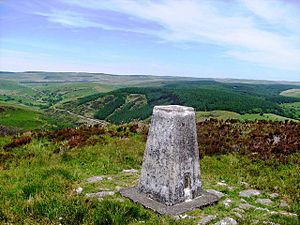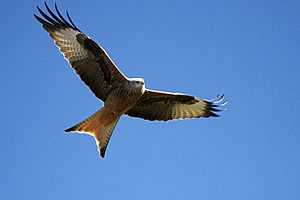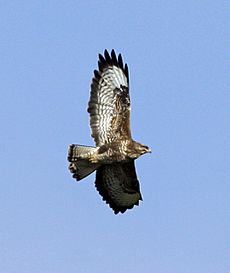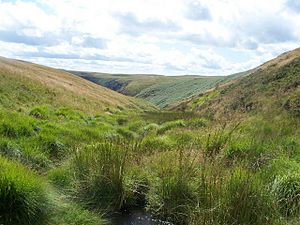Mynydd Mallaen facts for kids
Quick facts for kids Mynydd Mallaen/Crugiau Merched |
|
|---|---|
| Highest point | |
| Elevation | 462 m (1,516 ft) |
| Prominence | 205 m (673 ft) |
| Listing | Marilyn |
| Geography | |
| Location | Carmarthenshire |
| Parent range | Cambrian Mountains |

Mynydd Mallaen is a large, open area of high ground in Carmarthenshire, Wales. It's like a big, wavy plateau with steep sides. This area is part of the Cambrian Mountains. It sits northwest of a town called Cilycwm.
The land slopes down to the Towy valley on one side. On other sides, it drops into valleys with rivers like the Gwenffrwd and Afon Cothi. The highest point of Mynydd Mallaen is 462 meters (about 1516 feet) high. At the very top, you'll find two ancient stone piles called Crugiau Merched. This Welsh name means 'ladies' barrows'. These piles were built a very long time ago, during the Bronze Age.
You'll see many trees on the lower parts of the hill. Caeo Forest covers a lot of the southern side. Some of the natural woodlands here are made up of sessile oak trees. Not many people live on Mynydd Mallaen. You'll mostly find hill farms where people raise sheep. There are also some holiday homes for visitors.
Contents
What Mynydd Mallaen is Made Of (Geology)
The rocks that make up Mynydd Mallaen are quite interesting. They include different types of rock like mudstones and sandstones. These rocks belong to something called the Silurian period, which was a very long time ago in Earth's history.
These ancient rocks have been bent and broken over millions of years. This is what geologists mean when they say the rocks are "folded and faulted." The very top of the hill is made of a special rock called conglomerate. This rock looks like it's made of lots of pebbles stuck together.
During the last ice age, huge sheets of ice covered this area. When the ice melted, it left behind special types of clay and rocks called glacial till and boulder clay in some of the dips on the plateau. You might also see many white quartz stones scattered around. These could be what's left of ancient mineral veins that have worn away over time.
Ancient Discoveries (Archaeology)
Mynydd Mallaen has many clues about people who lived here long ago. Besides the two large stone piles at the top, there are other ancient round barrows (burial mounds) and tall standing stones. Two of these standing stones are very close to Crugiau Merched. One is even named Maen Bach.
A very exciting discovery on Mynydd Mallaen is the history of gold mining. The Romans started mining gold here around 75 AD, soon after they took over the area. You can still see the remains of their mines at a place called Dolaucothi.
The Romans were clever engineers. They built special water channels called Roman aqueducts to bring water to the mines. These aqueducts collected water from the River Cothi and Afon Twrch, Carmarthenshire. The water was stored in large tanks near the mine. The Romans used a method called "hushing" to find gold. They would release huge amounts of water from these tanks to wash away the soil and expose the gold veins in the rock. They also used water to wash gold from sand or to clean crushed gold ore.
Mining at Dolaucothi slowed down after 150 AD, but some activity continued until about 350 AD. There was also a very large lead mine nearby, north of the plateau, at Rhandirmwyn. This mine was one of the biggest in the world in the 1750s! There's even some evidence that smaller-scale mining might have happened there in Roman times too.
Animals and Plants (Wildlife)


Mynydd Mallaen is home to many different kinds of animals, especially birds. You can spot large birds of prey soaring overhead, like the amazing red kite, common buzzard, raven, kestrel, and carrion crow. The red kite is very special because it almost disappeared from other parts of the country due to hunting. This area became a safe place for them to live and thrive.
You'll also hear many songbirds, including the skylark. Skylarks love the wide, open grasslands below the main peaks because they build their nests on the ground. Pied wagtails are often seen near the streams and fast-flowing water coming down from the hills.
In the woods and forests, you might find foxes and badgers. The local rivers are full of fish like salmon, trout, and sewin. There are also many smaller mammals like field voles and rabbits.
In spring, the sessile oak woodlands on the sheltered hillsides are covered with beautiful common bluebells. These woods also provide a safe home for all the local wildlife.
Exploring Mynydd Mallaen (Access)
Good news for hikers! Mynydd Mallaen is considered "open country" under a special law. This means you are free to walk anywhere on the hill.
There are also specific paths you can follow. A bridleway (a path for walkers, cyclists, and horse riders) crosses the hill from east to west. Another bridleway comes up from the south.
Be aware that large parts of the plateau can be very wet underfoot, especially in areas of peat bog. So, it's important to be careful when walking on the top, as there aren't always clear footpaths. Apart from the two standing stones and the large ancient cairns, there aren't many obvious landmarks to guide you.


